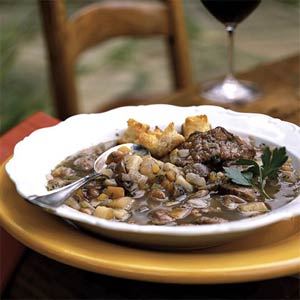

 The Accurate Reloading Forums
The Accurate Reloading Forums  THE ACCURATE RELOADING.COM FORUMS
THE ACCURATE RELOADING.COM FORUMS  Other Topics
Other Topics  Recipes for Hunters
Recipes for Hunters  Rabos de Toro San Fermín
Rabos de Toro San FermínGo  | New  | Find  | Notify  | Tools  | Reply  |  |
| one of us |
Rabos de Toro San Fermín Oxtails in the Style of San Fermín The Festival of San Fermín, held in Navarre's capital of Pamplona between 12:00 noon on July 6th and midnight of July 14th each year, is quite the party by all accounts - but of course, we here at FotW are interested in history, not partying - so here's some interesting information about the origins of this festival, from Wikipedia: http://en.wikipedia.org/wiki/San_Ferm%C3%ADn
Two of the most well-known events, the Running of the Bulls and the diurnal bullfights held in Pamplona's corrida (the fourth largest in the world) were immortalised in Ernest Hemingway's The Sun Also Rises. Everyone has heard of the Running of the Bulls, of course, but what has always interested me was the bullfighting, an ancient, almost sacred tradition that harkens back into the earliest reaches of civilisation, when ancient Minoans on the Greek island of Crete would dance with bulls in Knossos:  Not much later, gladiators would battle bulls (along with bears) in the arenas of ancient Rome:  These traditions found a happy home in Spain; this, from another Wikipedia article: http://en.wikipedia.org/wiki/Bullfighting
In Spanish culture, bullfighting eventually became a highly-ritualized event, forever fusing exotic, ancient beauty with fierce, primal violence in a timeless dance of blood and death between the bull and the matador: 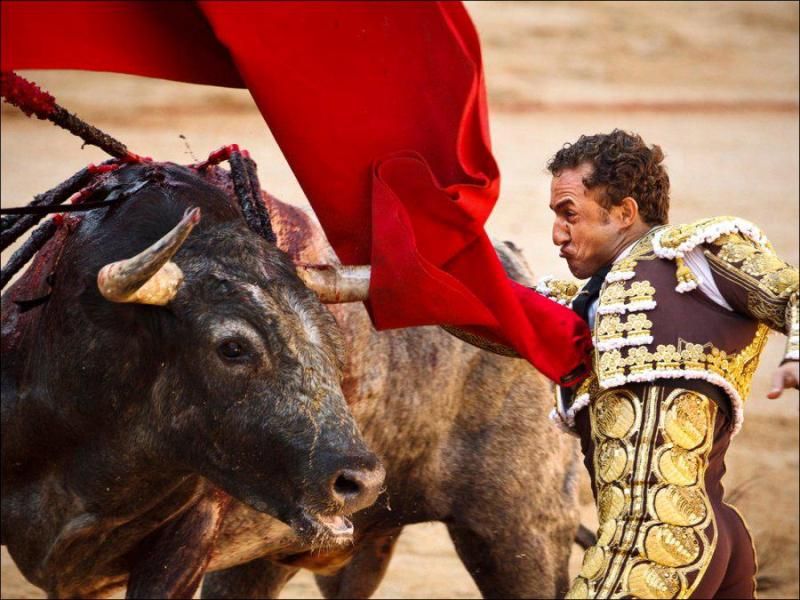 Short of actually experiencing a bullfight first-hand (a bucket-list goal of mine), one of the most effective ways to experience the drama and passion of the bullfight is to witness the paso doble, a Spanish dance that attemps to capture the interaction between matador and bull. The most vivid songs ever used to accompany this dance, in my estimation, actually comes from an American, Ritchie Valens, in the form of his Malagueña: Bullfights are held throughout Spain, but during the Festival of San Fermín, they take on an additional significance; from SanFermin.com: http://www.sanfermin.com/index...en/la-fiesta/corrida
With several bulls killed each day, there is no shortage of beef in town, and many traditions came about as to how it should be prepared for the festival-goers. One recipe that I've prepared uses the neck and shoulder meat: http://foodsoftheworld.activeb...e-toro_topic666.html I found it to be excellent, and highly recommend it to anyone wishing to try something new. Along with the neck and shoulder meat, the tail (commonly called oxtail) is also a great candidate for slow braising or stewing, which allows the fats and connective tissues to render down and provide melting tenderness to the flavourful, hard-working cuts of meat. It is only natural that oxtail stew would become a tradition during the San Fermín festival, with the evolution of a unique style all its own; indeed, oxtail stew San Fermín style has been adopted by the Government of Navarra, and is served in all its glory during the Festival of San Fermín, when the events of the week ensure that there is an abundance of oxtails. It is an old, old recipe that has been copied since the Middle Ages, and when I saw it, I immediately fell in love with it and wanted to try it; also, the timing was great: I was able to prepare it in time for the evening of the close of the Festival of San Fermín on 14 July 2012. I do believe that I was able to create this dish as faithfully as I could, using the recipe and some discussion with Margi as a guide, and that I was able to provide a close rendition of oxtail stew in the style of San Fermín. Here is the recipe, from the Hotel & Tourism Ministry of the Culinary Technical Department of Spain: 1 decilitre olive oil 1 Medium-sized onion, finely chopped 200 grams carrots, peeled and finely chopped 500 grams red, ripened tomatoes, finely chopped 2 Oxtails Salt and freshly-ground black pepper 40 grams flour 2 decilitres home-made beef stock 1 Litre of Sherry 1 Sprig fresh parsley, finely chopped 1 Sprig fresh thyme, finely chopped 1 Sprig fresh rosemary, finely chopped 1 Sprig fresh oregano, finely chopped 1 Laurel (bay) leaf 500 grams potatoes, cut into steak fries 50 grams almonds 1. Mince and finely-chop finely the vegetables 2. Sauté the vegetables in the olive oil, then set aside in a casserole, Dutch oven etc. 3. Salt and grind some freshly ground black pepper on the oxtails. 4. Dredge the oxtails in flour, shake off excess, and brown them in hot olive oil in batches until golden on all sides. Add the oxtails to the vegetables. 5. Pour the Sherry & the beef stock into the casserole until the oxtails are covered. 6. Slow simmer over a low flame for 90 minutes or so, until the oxtails are tender and the sauce is a nice, thick gravy. 7. Peel the potatoes and fry in a skillet until golden. 8. Sauté the almonds together with the potatoes. 9. Stew all together for 6 to 7 minutes on low a simmer; then add the fresh or dried herbs, stir carefully and serve. Note: As you can see, the amounts of the ingredients are metric; however, it is easy to approximate them, as you will see below.For the less adventurous, about.com provides a great conversion calculator here: http://southernfood.about.com/library/info/blconv.htm Let's get this going! Here's all you need: 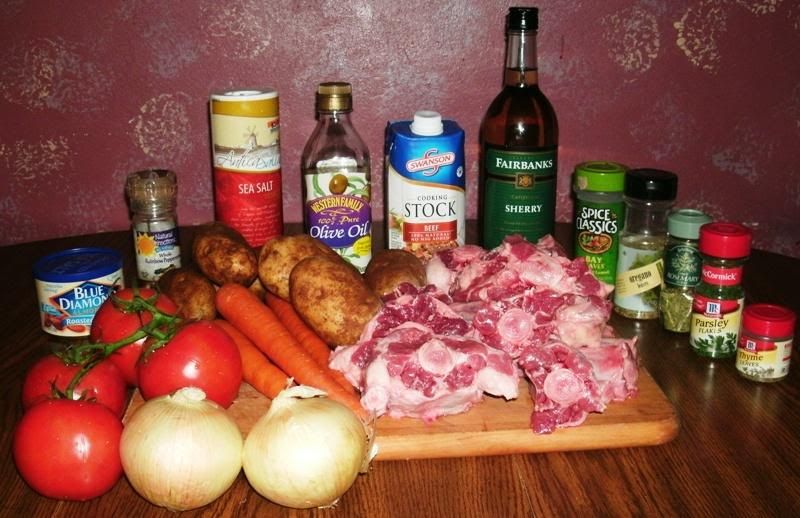 Do you see anything elaborate or complicated there? Me neither! The stars of the dish, of course, are the oxtails: 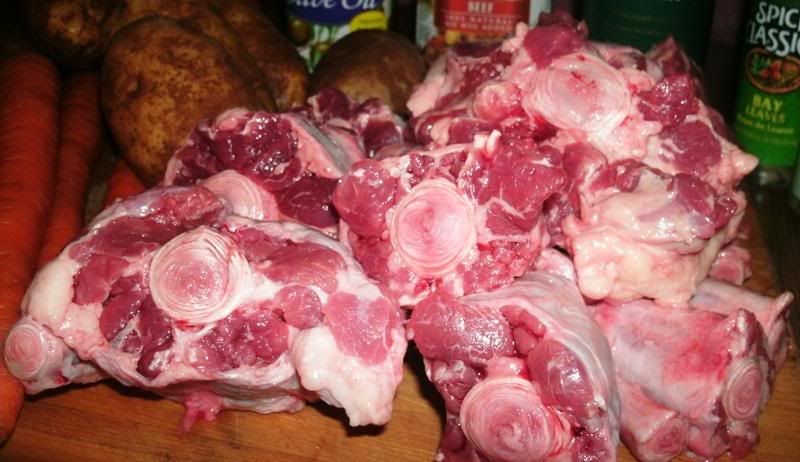 As you can see, the larger pieces have a good amount of meat to them; cloaked in sheathes of fat, connective tissue and gristle, to be sure, but just waiting to be brought to their full glory through long, slow braising. Preparation for this fundamentally-humble dish begins by chopping the vegetables; first, the onions: 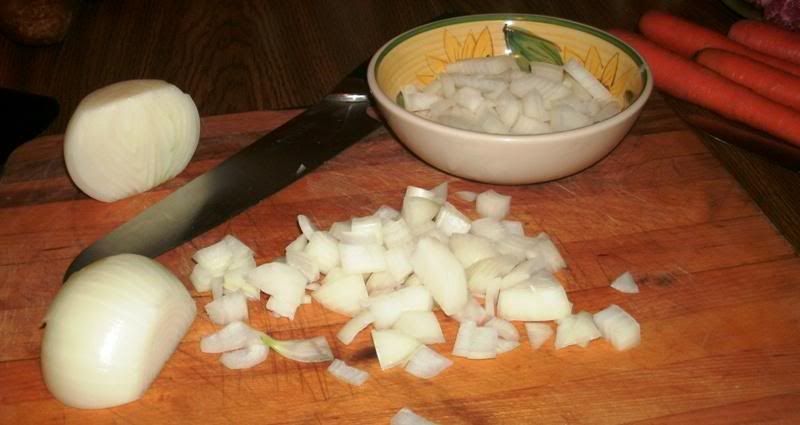 Next, the carrots: 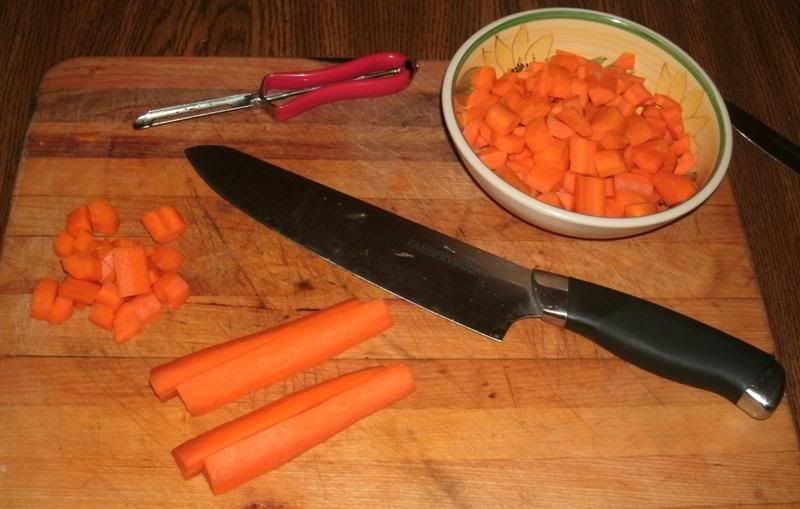 And finally, the tomatoes: 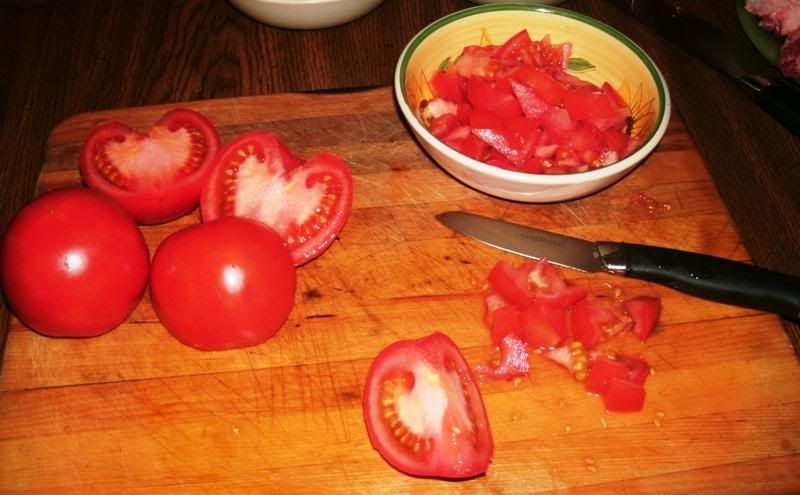 There we go - easy enough: 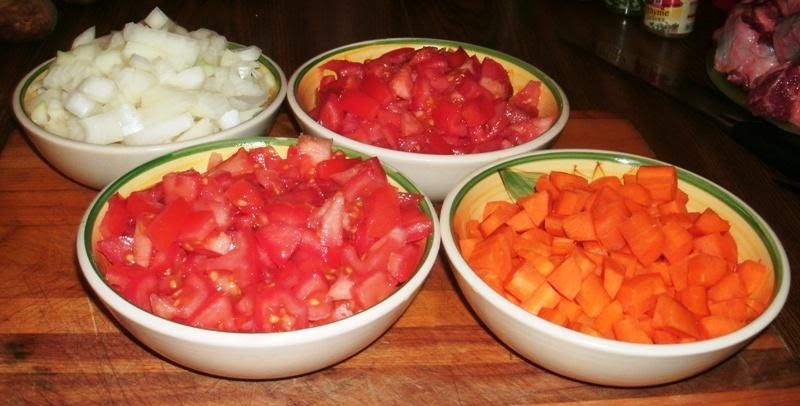 That's really all the prep work that we need to do in order to get this started, so let's get started! First, sauté the onions and carrots in olive oil: 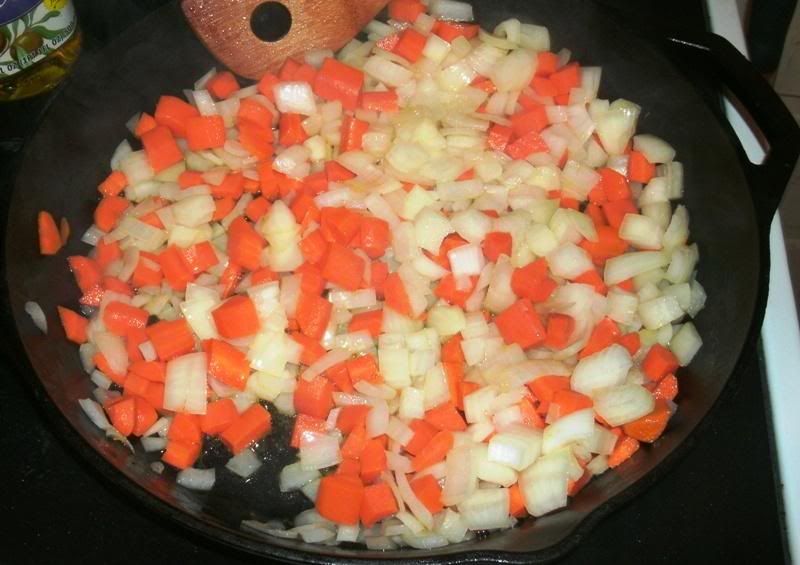 A cast iron skillet works very well for this. When the onions are beginning to turn translucent and get soft, add the tomatoes: 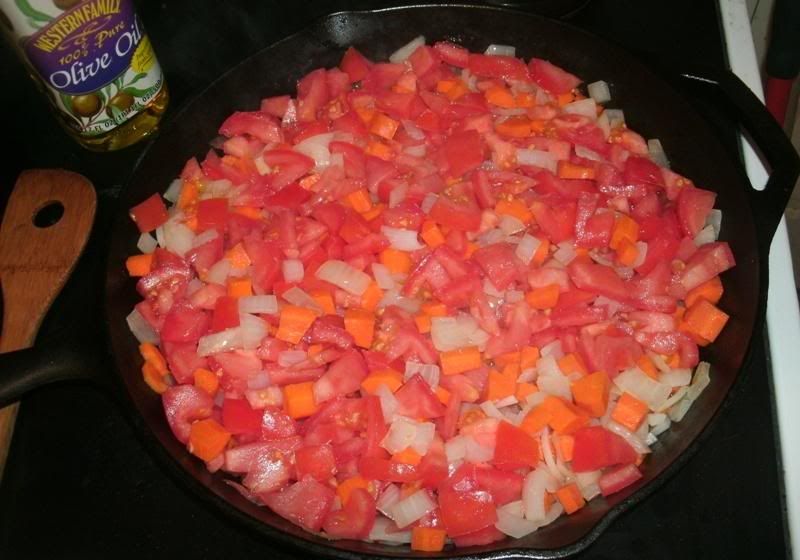 Continue to sauté this while the vegetables turn into a sofrito: 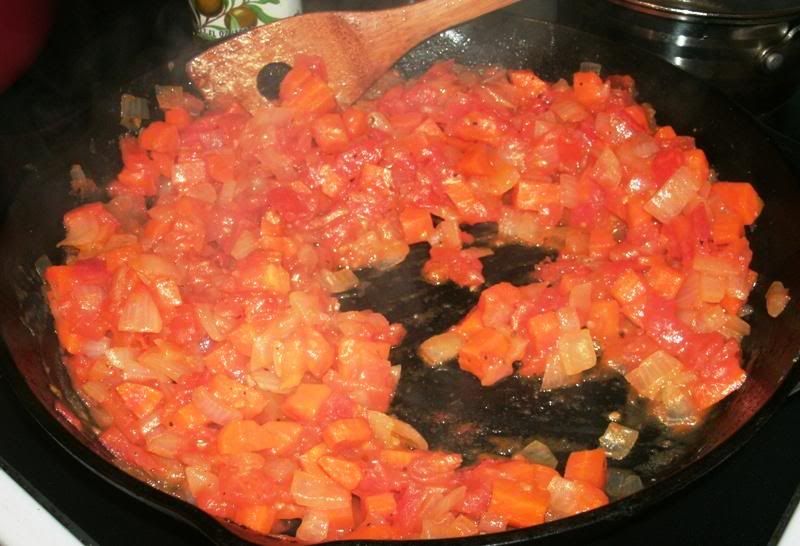 And then set the mixture aside in a casserole or Dutch oven; here, I've de-glazed the vegetable fond with some Sherry and added it to the sofrito in my enameled cast iron Dutch oven: 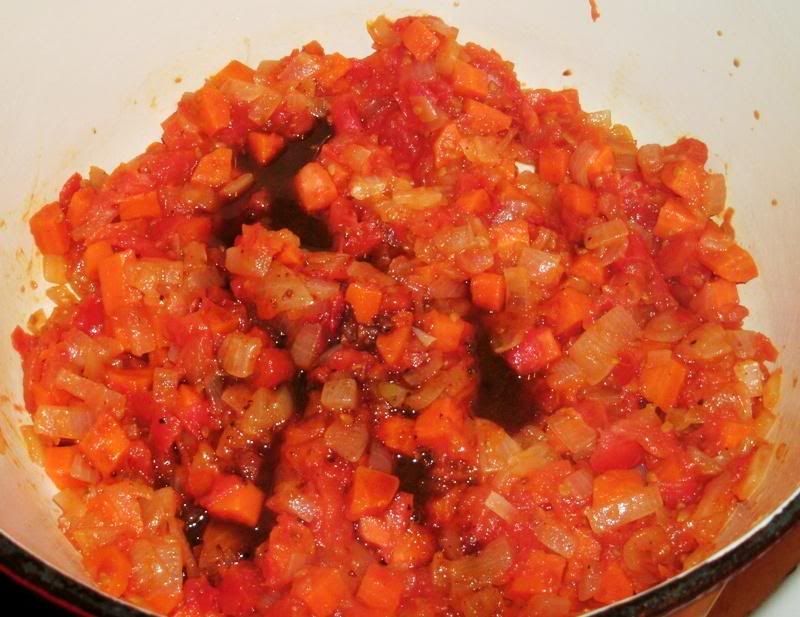 Next, I gave my oxtails a moderate salting and a generous peppering, then dusted them with flour and browned them in olive oil: 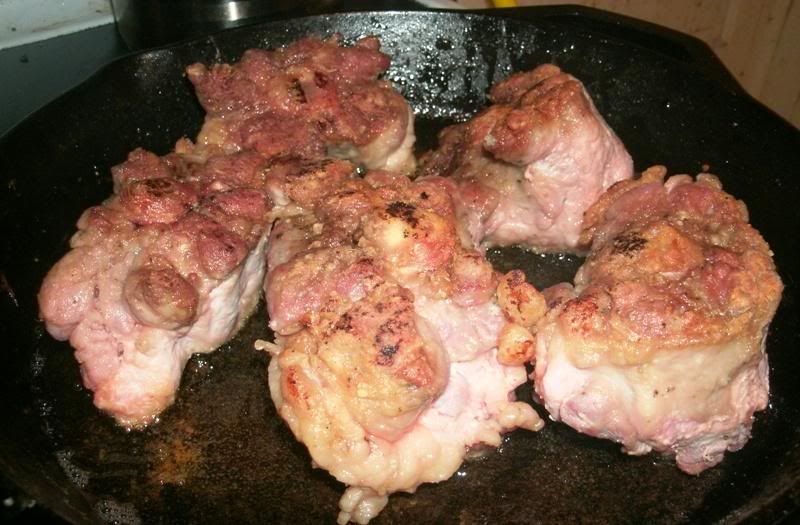 I did this in several batches, starting with the larger pieces and ending with the smaller ones: 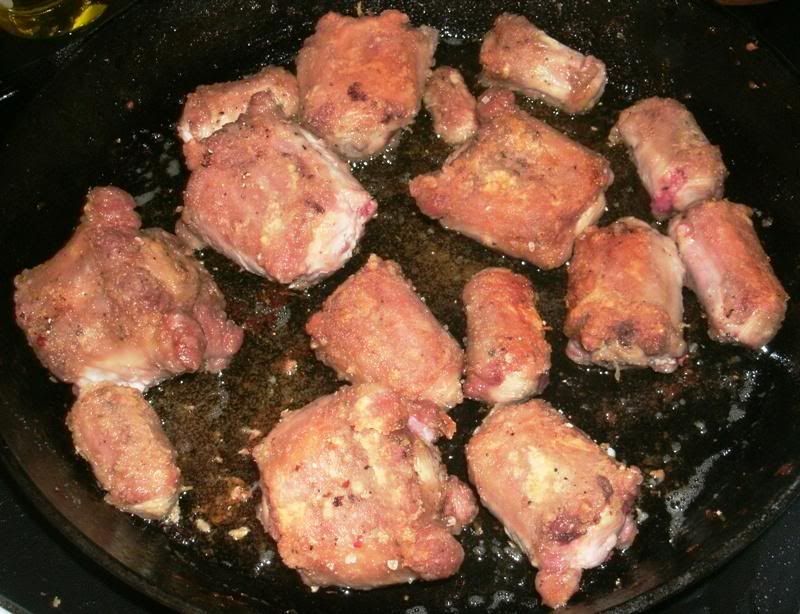 As the pieces browned, I added them to the Dutch oven: 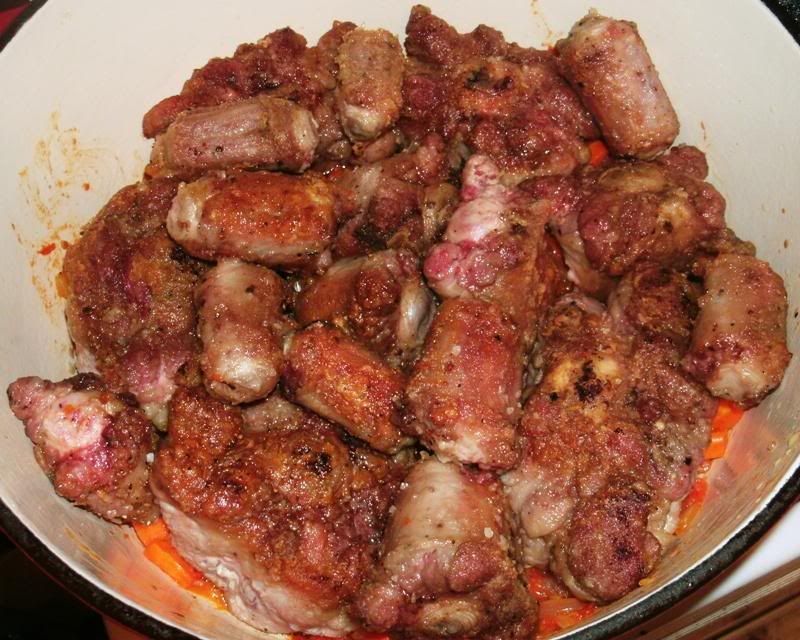 I then de-glazed the cast iron skillet with some Sherry: 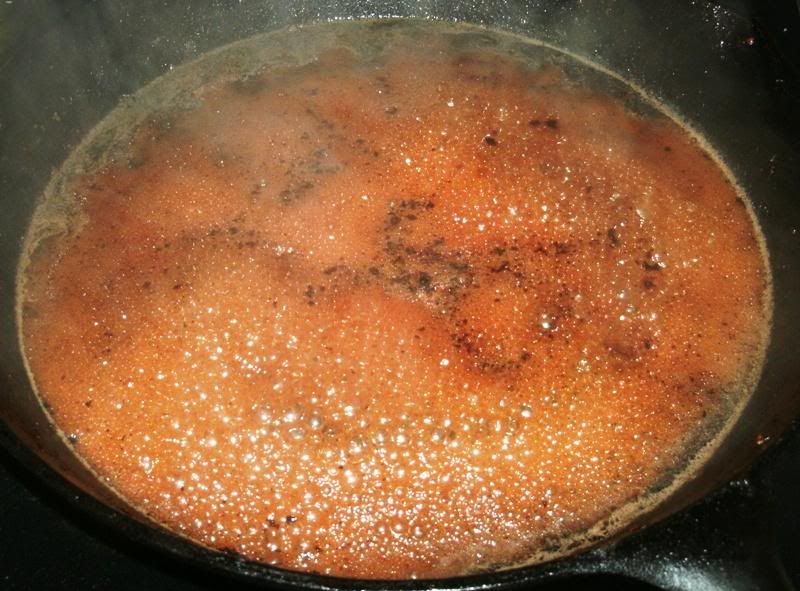 After adding the de-glazing liquid to the casserole, I then added the beef stock and the rest of the Sherry: 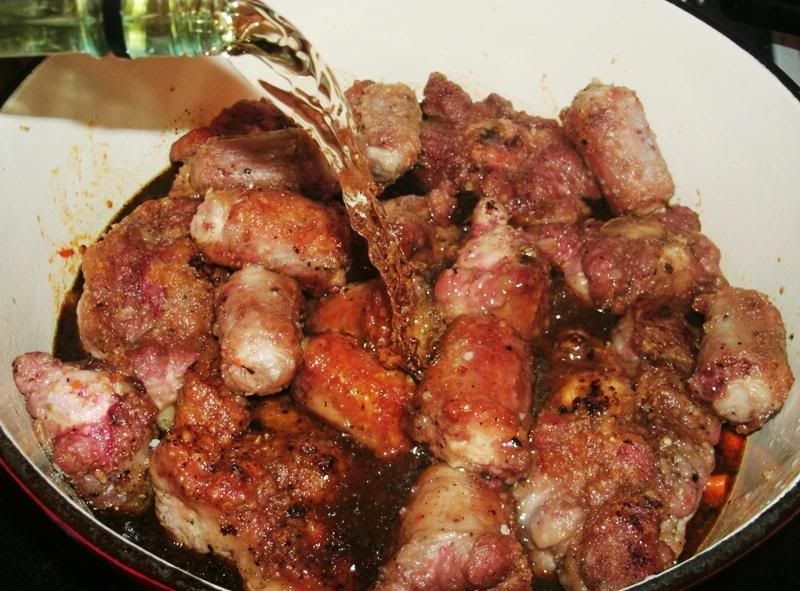 It took the full litre of Sherry - and nearly the same amount of stock - to cover everything in the Dutch oven. I then added the bay leaves: 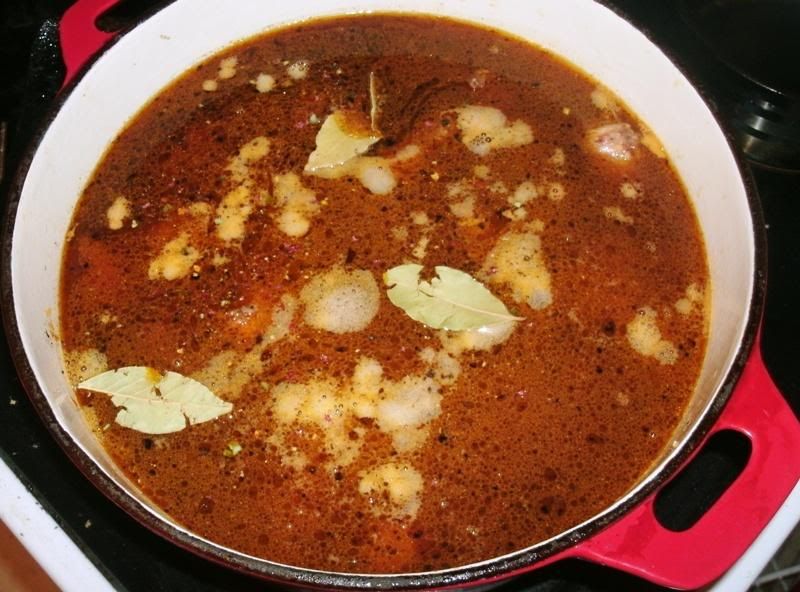 Next, I brought everything to a slow, barely-bubbling simmer on the stove-top, covered the Dutch oven, and set it in the pre-heated oven at 300 degrees to braise. Meanwhile, I prepared the potatoes for their bath in hot olive oil by slicing them into steak fries: 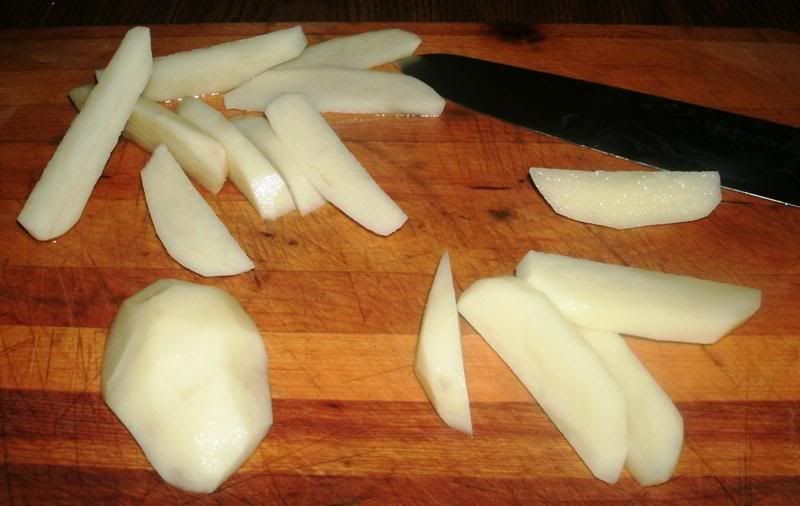 I held the fries in cold water, rinsing them and changing the water 2 or 3 times to keep it clear: 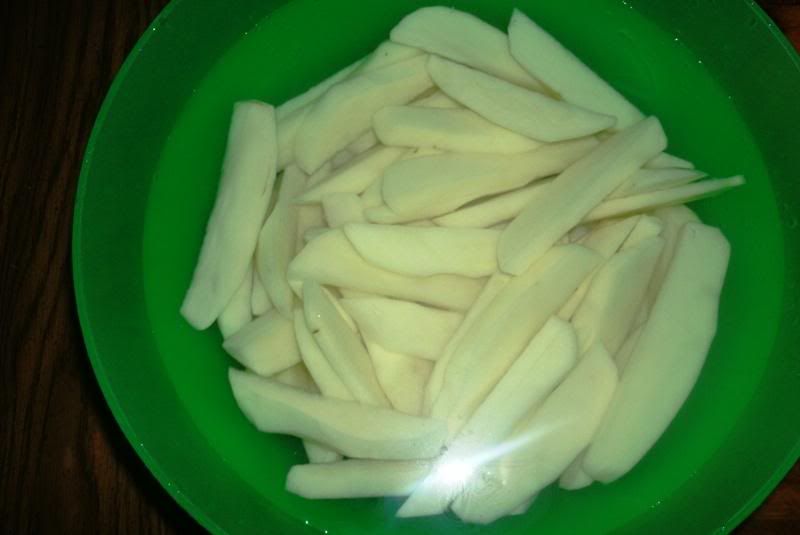 After about an hour and a half, I added the herbs to the stew: 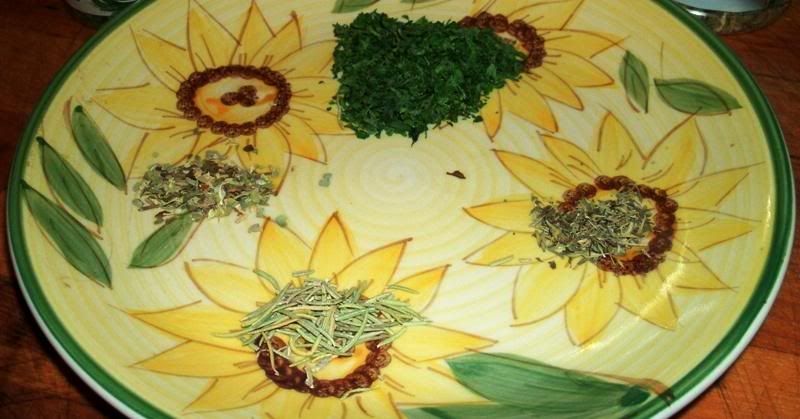 It was really starting to look good, with incredibly rich aromas coming from the beefy oxtails as they swam in the Sherry and beef stock, melding their flavour with the vegetables: 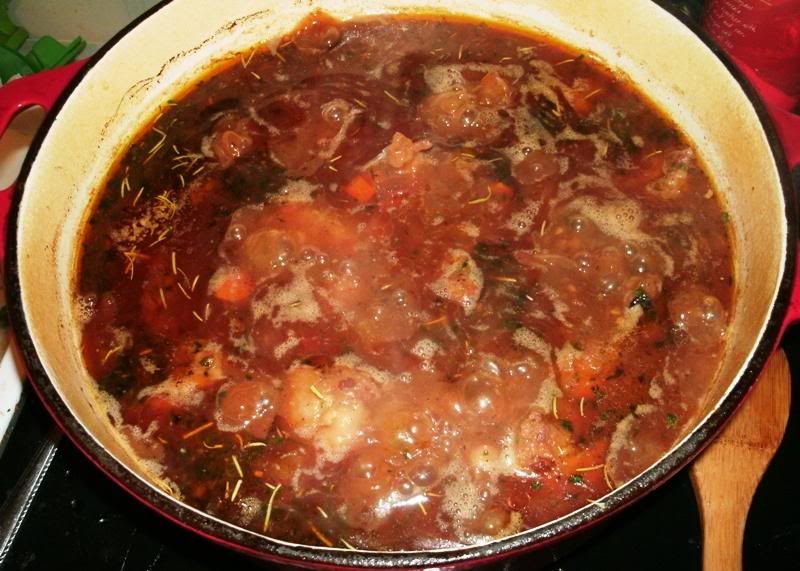 I let the stew continue to simmer, uncovered, as I fried the potatoes in batches along with the almonds: 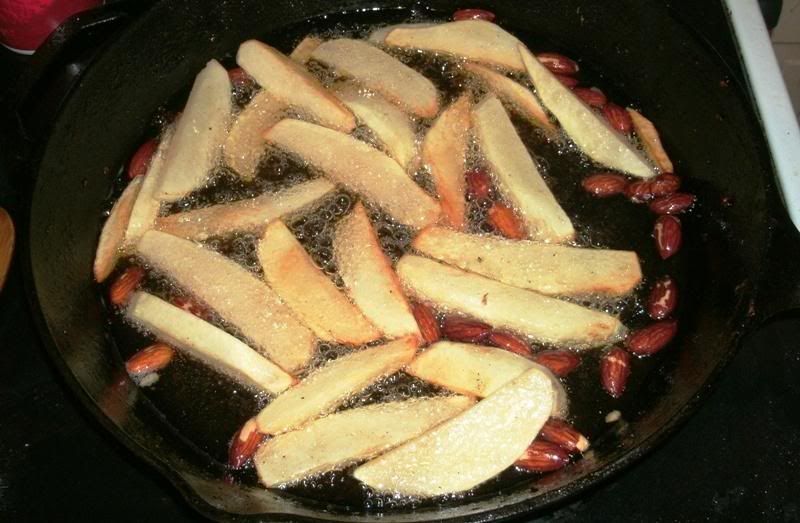 It is here that I probably made one mistake: I fried the almonds and potatoes at the same time, when it probably would have been better to add some almonds toward the end of each batch of potatoes. As it was, the almonds got really dark, but took on a very nice, roasted, nutty flavour, so perhaps I did well after all. As each batch of potatoes turned golden and crisp on the outside, remaining tender and fluffy inside: 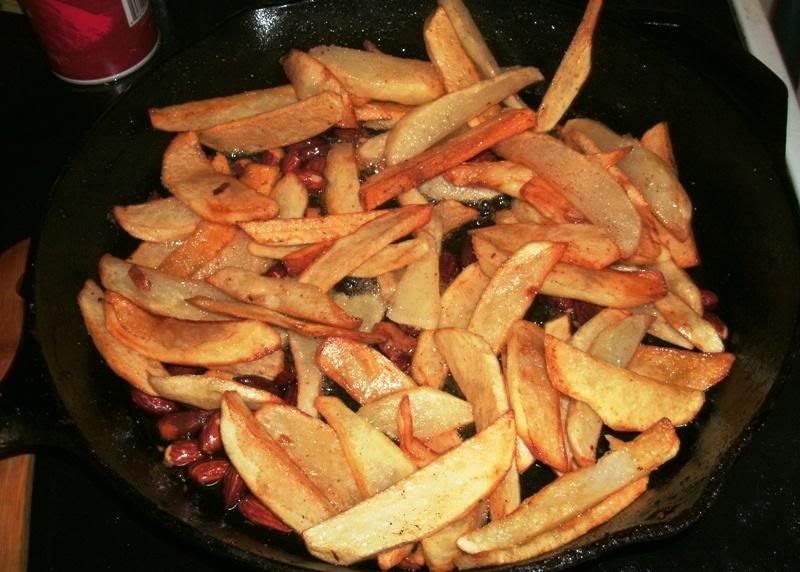 I removed them to drain on a rack, tossed a little bit of sea salt on them, and continued with the next batch until all the potatoes were finished. By this time, the stew still hadn't quite thickened up the way I preferred. To thicken it up, I made about 3 tablespoons of cornstarch slurry, rather than reduce for a couple of hours, which I would have preferred to do. This wasn't much of a problem, since I simmered the stew long enough to "cook" the cornstarch into the dish, but it is something to be aware of. I served the oxtails alongside the potatoes, covering everything with the rich, mouthwatering gravy: 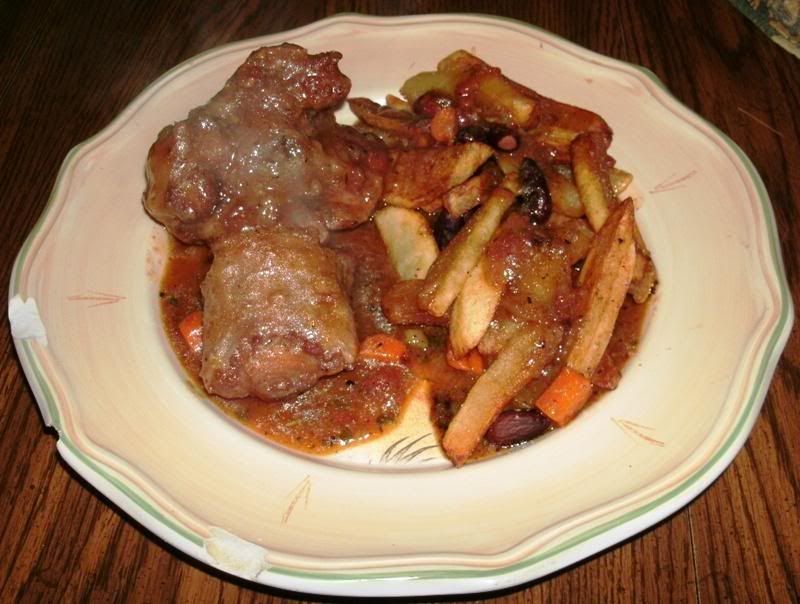 One look at this and you can see just what all the fuss is about in Pamplona: 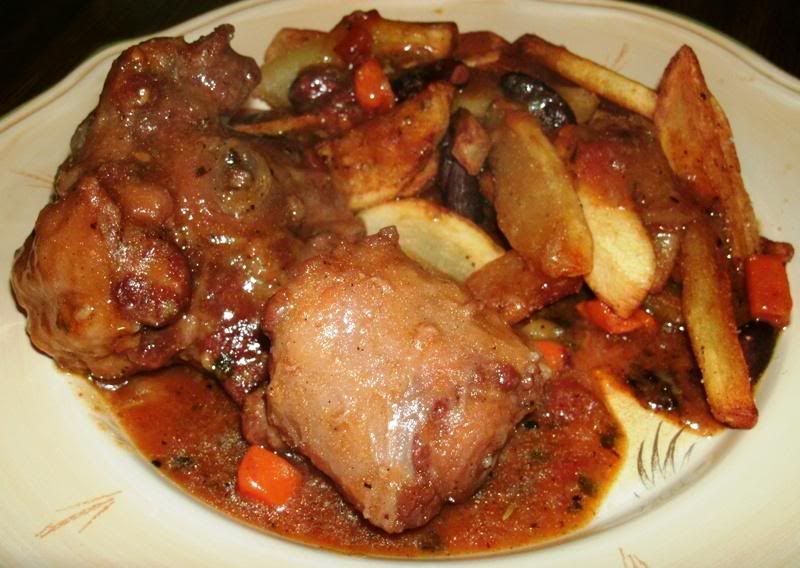 I was happily surprised by my effort with the steak fries - I haven't had much luck with them in the past, but this time I made sure the oil was quite hot, and they turned out very well: 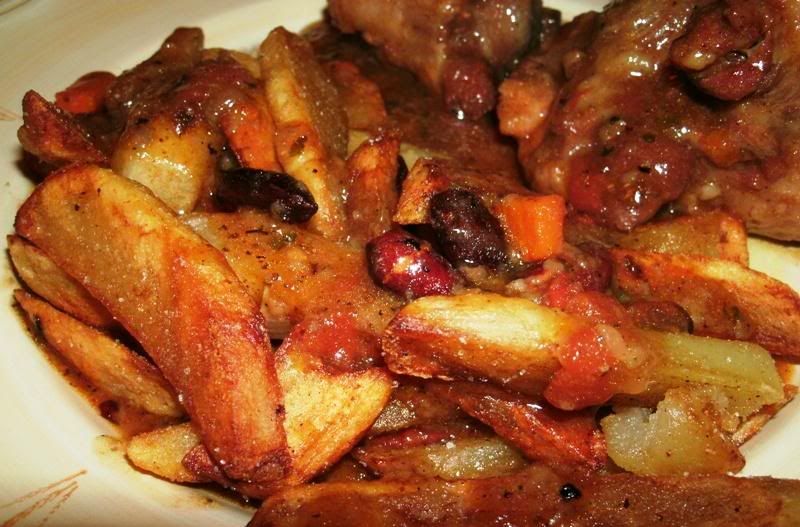 All-in-all, I enjoyed this dish very much, finding it to take in all of the wonders that I would imagine one would find during the San Fermín festival. Just looking at the oxtails and smelling them was enough to make the mouth water, but the flavour was out of this world. The slow braising of the oxtails reduced the meat, connective tissues and fat to wonderful fork-tender chunks of pure, beefy goodness with all of the savory, melty texture that comes from such cuts of meat. They worked very well with the Sherry, which I had never tasted or used before, and I can say with absolute certainty that I was impressed with the entire dish. It was very, very delicious, with a purely Spanish combination of flavours, and was quite easy to prepare. 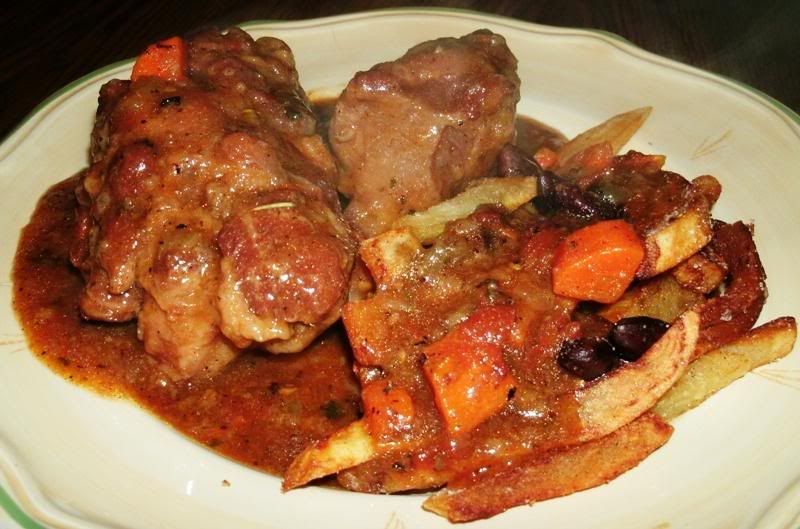 There were a couple of minor drawbacks; for me, the biggest was the high cost of the oxtails, which I was unprepared for. Two oxtails were in the neighbourhood of 21 dollars total, and probably less than half of those had much meat on them; what meat there was was delicious, but there wasn't much. I was expecting this to an extent, and the fat/collagen benefits of the meat should absolutely count for something, but I would be surprised if there was much more than a half a pound of actual meat between the two oxtails. My purchasing them nearly caused a divorce, considering the amount of meat in return for that kind of cash layout; the beautiful Mrs. Tas was not interested in hearing about the subtle qualities of oxtail - she said something about over-priced bones. The bottom line is that oxtails are definitely NOT a "cheap" cut anymore, and they have gone up-town, just as skirt steak, brisket and other once-frugal cuts have become fare for the well-to-do these days. Other issues included the thickening I had to do and the probable over-toasting of the almonds, but these were very minor points that probably wouldn't have even been noticed during the drunken orgy that goes on in Pamplona in July. None of this changes the fact that this dish was excellent and outstanding. Using my "by the book" first attempt, where I followed the recipe. as closely as I could, I can see some real potential for this with a few slight modifications that would easily make this a regular "do-again" dish at our house. Most importantly, I will in the future make this with cubes or chunks of chuck or other roast, and will probably serve the stew with roasted or mashed potatoes. These are minor things that, in my opinion, do not change the excellent flavour, but rather make the dish a bit more practical for our budget and tastes. My final word on this dish is to very highly recommend it, with or without the modifications mentioned above! | ||
|
| one of us |
Haven't made it in a while so I wasn't aware that the price was so high ! What you should better explain is that the braised oxtail is LOADED with Flavor !!. I used to get privately raised beef and I always asked for the tail.Finally my friends asked why ? I gave them a recipe and they discovered why ! The Italians call it Coda di Bue Brasato [braised oxtail] .The oxtail should simmer tillthe meat starts to fall from the bone which will take 3-4 hours. We need a Smiley of someone eating !! | |||
|
| one of us |
these babies were good for sure - i know my wife was aghast at the price, and i understand that, but the flavour, tenderness and aroma were out of this world. i am willing to bet that i can get the same results with chuck roast carved into large cubes or chunks, and will be doing this again. these braised for probably 2.5 hours altogether, maybe 2.75 ~ they came out fork-tender wonderful, but of course with cuts like this, they can braise almost forever and they only get better. i'm considering checking with a local slaughterhouse to see if this might be a "giveaway" cut there - evidently, the cuts that they don't actually sell iether get ground or are pretty much eligible to be given away. | |||
|
| one of us |
Chuck roast -same results ? No way ! | |||
|
| One of Us |
It's a tradition to have ox tail soup the day after killing a Cape Buffalo. The recipes vary, but the tail is definitely rich, and flavorful. I've got to try this one. | |||
|
| Powered by Social Strata |
| Please Wait. Your request is being processed... |
|
 The Accurate Reloading Forums
The Accurate Reloading Forums  THE ACCURATE RELOADING.COM FORUMS
THE ACCURATE RELOADING.COM FORUMS  Other Topics
Other Topics  Recipes for Hunters
Recipes for Hunters  Rabos de Toro San Fermín
Rabos de Toro San Fermín

Visit our on-line store for AR Memorabilia

